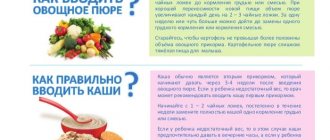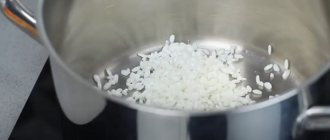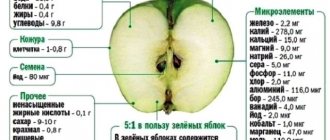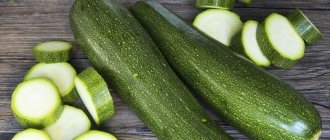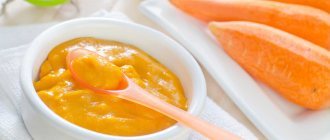07/29/2020 Reading time: 3 min 66435 0
The earliest date for starting complementary feeding is 4 months1. When exactly to introduce your baby to “regular food”, check with your pediatrician. Complementary foods cannot be introduced2:
- during illness,
— 3-5 days before and after vaccinations.
What is complementary feeding?
Complementary feeding is everything that a baby eats up to one year, except for mother's milk and infant formula1.
How do you know when it’s time for your baby to introduce complementary foods?
Why does your baby need extra feeding?
- Loss of weight occurs;
- Between feedings, the baby is restless, whiny, and demands the breast;
- The baby is constantly hungry, as evidenced by the characteristic crying;
- The child is interested in his spoon;
- The baby does not push the contents of the spoon back. Try letting your baby drink water from a spoon. There was water on the chest - it was too early to introduce complementary foods.
- The child must hold his head well and be able to sit. Lying down, he will not be able to demonstrate to his parents that he does not want to eat;
- The baby begins to teethe;
- The baby watches with interest how his parents eat.
You cannot introduce complementary foods yourself, without consulting a pediatrician.
The benefits of timely introduction of first complementary foods
It is important not to miss the time when introducing new products is really necessary. When formula feeding, feeding often begins early. Complementary feeding from 5 months while breastfeeding also has its positive aspects. How and what are its benefits:
- The first food replenishes the deficiency of essential substances;
- Improving the functioning of the gastrointestinal tract;
- The baby learns to develop chewing skills and trains its jaws to chew food independently.
How to introduce complementary foods at 5 months - features and general rules?
The main rules for introducing complementary foods so as not to harm the health of a five-month-old baby:
- In case of illness, it is necessary to postpone complementary feeding of a five-month-old child until he is completely recovered;
- If vaccination is planned, then you should not introduce a new product a week before and a week after;
- New product is offered in the morning;
- Input begins in minimal volumes (half a teaspoon), gradually increasing the portion;
- One product is introduced, if no allergies are observed in 6-7 days, a new one can be added;
- Usually they start with vegetable purees, gradually adding cereals and fruits.
On a note! If a child is significantly underweight, pediatricians recommend starting with cereals, and then adding vegetables and fruits;
- Mashed potatoes or porridge should be prepared before use; it should not be given to the baby when heated twice;
- Food should be at room temperature.
Complementary feeding and allergies
Improper introduction of complementary foods can lead to an allergic reaction
How to properly introduce complementary foods to a 5-month-old child with allergies?
- Mothers with allergies need to breastfeed their babies longer;
- Allowed first vegetables: zucchini, cauliflower;
- First fruits: green apples, ripe bananas, pears;
- The introduction of a new product to children with allergies begins with a quarter of a teaspoon, monitoring the baby’s reaction;
- Preference should be given to ready-made canned puree;
- Porridges must be gluten-free. Preference is given to buckwheat and rice.
What should not be included
When choosing ready-made puree in jars, pay attention to the composition: it should contain only natural ingredients. The ideal composition of a one-component puree is vegetable (fruit), water. And also must be absent:
- Salt;
- Sugar is not a desirable component of baby food; try to avoid products containing it;
- Flour;
- Dyes, preservatives;
- Starch (can cause constipation, abdominal pain);
Starch is not officially prohibited in the use of baby purees, but why then do some manufacturers not indicate it in the composition?
The vegetable itself may contain starch, but when starch is added “on top” it is too much, iodine immediately gives a reaction to such purees.
Vitamin C is questionable. It may cause allergies in some children.
Fruit and vegetable treats should also not be expired, have signs of opening or deformation of the packaging.
Humana
The rating of baby purees is opened by the company Humana, which has become the choice of many mothers in 2021. The production of baby purees is based on the complete elimination of preservatives and contains only natural products. Organic puree contains all the microelements necessary for a child. All components were grown without the use of pesticides and harmful fertilizers; their balance makes Humana healthy and tasty.
One of the features of Humana’s company is the use of uniform recipes for all factories in the world.
Each type of product has high quality control, which allows the company to be included in the baby food rating every year.
Advantages:
- natural products;
- age categories from 4, 6, 8, 10 months;
- without salt and sugar;
- no preservatives;
- quality control;
- single recipe;
- hypoallergenic composition;
- recommended for diabetes.
Disadvantages: none found.
Vegetable purees are packaged in 125 gram glass jars, the average cost is 75-120 rubles. Fruit ones also have a volume of 125 grams, but the average price is already 75-140 rubles. Purees with a full dish (for example, Carrots with potatoes and chicken or Pumpkin with rice and chicken) are packaged in 190 gram glass, the price is 145-187 rubles. Among the unusual flavors we can mention Humana Pear-Mango Puree.
Gerber
The best baby food cannot do without the Gerber brand. The history of puree began when Dorothy Gerber decided to prepare puree for her child at her husband’s business. A modern company is careful about the quality of its products, from preparing seeds for future components to selling finished jars.
All fruits and vegetables are grown in environmentally friendly areas. Quality control is carried out in laboratories built on the territory of the enterprise. Particular attention is paid to the sterility of products.
The wide range includes different types of purees - single-component, multi-component, fruit in soft packaging, vegetable with the addition of meat and fruit and milk. An innovative solution was soft drinking packaging, the puree from which can be consumed conveniently on the road or on a walk, and takes up little space.
Advantages:
- without salt and sugar;
- age categories: first stage (4 months), 6, 8, 10 months;
- a series of fruit and milk purees;
- innovative soft packaging;
- hypoallergenic products;
- no preservatives;
- high-quality and fresh raw materials.
Disadvantages: none found.
The cost of Gerber purees varies from 39 to 319 rubles.
Nutricia
Nutricia is included as a leader in the rating of baby cereals and milk formulas for newborns, but the purees of this company also occupy a high position in popularity among mothers. In Russia, Nutricia is known as a division of Danone.
The brand has identified 4 groups for purees: orange (fruit), beige (fruit with yogurt), red (meat and fish) and green (vegetables).
Three stages of baby puree have been developed for baby food:
- vegetable and fruit - recommended from 4 months;
- fruit and cottage cheese, vegetables with meat - recommended from 6 months;
- vegetable and meat with pieces - recommended from 8 months for the development of chewing abilities.
Advantages:
- without salt and sugar;
- without preservatives, dyes and flavors;
- quality control;
- division into stages of introduction of complementary foods.
Disadvantages: none found.
The price ranges from 37 to 75 rubles.
Grandma's basket
The best baby food in Russia is associated precisely with grandmothers, who treat their grandchildren with special care. To make Babushkino Lukoshko puree, only high quality natural products are used.
The production uses technology that allows us to preserve all the nutrients that benefit any child.
Suppliers of raw materials guarantee an environmentally friendly product that excludes the use of genetically modified fruits and vegetables. Also, no dyes, flavors or preservatives are used.
For sale, two types of puree packaging are used - in jars (100 grams) and soft drinking doy-pack packaging (90 grams).
Advantages:
- without salt and sugar;
- no preservatives;
- soft drinking packaging;
- environmentally friendly products.
Disadvantages: none found.
The price varies from 25 to 110 rubles.
Fruto Nanny (Russia)
A well-known Russian company that produces varieties of food for children offers a wide range of healthy products for children of all ages. Porridge of various consistencies, with and without pieces of fruit, purees: meat and vegetables, as well as fruit purees in jars, beloved by all children.
In addition, juices and fruit nectars, dairy products and drinking water. The company produces a unique line of products with hypoallergenic properties.
Advantages:
- A wide range of;
- Affordable price;
- Natural vitamin composition;
- Does not cause addiction;
- Amazing taste.
Disadvantages: none identified.
Heinz
The German brand was founded in the 19th century. Today, production of products is also on the territory of the Russian Federation. The plant is equipped with the latest equipment, modern technologies and scientific achievements are used in production, and it has its own laboratory. The company produces complementary feeding products: cereals, baby purees, snacks, puddings, pasta. The porridges presented in the catalog are dairy, dairy-free, drinking, ready-to-eat, with pieces of fruit, berries or vegetables. There is a series of low-allergenic cereals. Children's fruit puree is available in packets and glass jars of different sizes (22 items). Vegetable puree – 7 types. Meat - 11 items, fish dishes - 2 types. 6 types of children's cookies with different compositions, in different packages for ease of use. The company also produces granulated tea (3 types).
Heinz puree advantages:
- Huge assortment;
- Affordable price;
- Children especially like this brand of porridge;
- Own raw materials, multi-stage quality control system.
Flaws:
- Some types of products contain sugar and salt;
- There is no fish puree in its pure form, only together with vegetables.
Bebivita
The company makes baby food from the best ingredients without sugar. Only natural saccharides are present. The products are free of gluten, salt and flavorings. The puree contains corn oil, which is a source of omega acids. And using rice flour provides better consistency and is also rich in amino acids and fiber.
As a first complementary food, food from cauliflower, zucchini, broccoli or carrots is available. The age of the child is indicated on the packaging. The recipe complies with European standards regarding children's nutrition. The products contain vitamins that are important for the full development of the baby.
Advantages
- Soft consistency;
- The mixture is thoroughly crushed;
- Contains useful components;
- Natural pleasant taste.
Disadvantages: Contains rice flour.
Parents note the good taste of Bebivita baby food. As well as the use of safe products for the composition. There are positive reviews about the quality of the packaging and the affordable price.
HiPP
Country: Germany Average price: 67 rub.
See Also News
Seafood company creates vegan shrimp
A German manufacturer with a long history guarantees the highest quality of its products. Baby food using special technology and natural ingredients provides parents with peace of mind and babies with a pleasant taste. HiPP produces powdered milk formulas for healthy children and dietary nutrition. They are enriched with vitamins and hypoallergenic. The range also includes fish and meat purees, creamy texture soups and much more. Recently, vegetable and fruit purees, dairy desserts and bio-juices were added to the product line. An important feature of HIPP is the absence of sugar in its composition. Organic ingredients retain the most beneficial microelements and support the healthy development of the baby.
Advantages:
- there is everything for feeding children from birth to 3 years;
- good taste;
- there are products for indigestion;
- hypoallergenic products.
Disadvantages: high price.
Puree "Bibikol"
Fruit and milk purees for children of the Bibikol brand are a premium quality product that is ideal for feeding small children. All Bibikol purees are produced using Organic technology. This means that the company does not use synthetic fertilizers and pesticides when growing fruits and vegetables, so these products are completely safe even for children of the first year of life. Despite the fact that Bibikol is a Russian brand, the production itself is located in Germany, which for many parents is an additional guarantee of quality and safety.
Unlike other brands, the Bibikol line of baby purees does not contain purely vegetable or fruit purees. A dairy component based on goat milk (yogurt or cottage cheese) is added to all products, which has a positive effect on digestion, helps normalize sleep and enriches the body with essential minerals. It is for this reason that this brand of food is suitable for children prone to allergies and suffering from mild forms of lactase deficiency.
An important difference between this brand is a very interesting assortment of flavors that others or “Zucchini, parsnip and goat’s curd” do not have. And some people even use puree with cottage cheese, tomato and red bell pepper instead of pasta sauce, so you can also give Bibikol baby puree a solid A for its taste. Due to the presence of dairy products, puree is suitable for children over 6 months.
Semper
The Semper brand has gained great trust among parents due to its high-quality composition. On sale you can find purees from zucchini, carrots, broccoli, and pumpkin. They contain only appropriate vegetables and water. For a four-month-old baby, the choice is prunes, blueberries, apples, and pears.
The puree is produced in Sweden. Understanding that fruits in European countries are considered one of the most environmentally friendly, allowed us to include the brand in the ranking of the best. The consistency is homogeneous, without lumps. Therefore, puree is optimal for introducing little gourmets to their first complementary foods. No allergic reactions were observed in children. The cost is quite high. On average, 100 rubles per 80 gram jar.
Subject
Our experts gave the next place in the ranking to the baby food manufacturer Tyoma. The brand is famous for producing delicious meat puree for little gourmets. Tema has a line of vegetable and fruit dishes, which are also popular. The manufacturer takes into account the traditions of first complementary foods, and therefore takes care of the composition. It contains only the main product and water.
On sale you can find pureed zucchini, broccoli, and pumpkin. All products are hypoallergenic. According to consumer reviews, vegetable products are too liquid in consistency. There are no complaints about the taste. Most children liked the brand's products. In online stores, a jar of puree costs from 40 rubles. Meat dishes are more expensive.
Swaddle
On the last lines of the rating is Russian puree. Vegetables and fruits for cooking are grown in the Volgograd region. To preserve the maximum benefits from nature, products are made during the harvest season and then use the “cold rub” method. There are no harmful chemicals or sugar in the composition. Introducing the dish into the diet does not cause allergies.
The liquid consistency is ideal for the very first feeding. However, some customers have complained about small particles in the pumpkin puree that could be processed seeds. Glass containers have stickers on the sides indicating the integrity of the jar. A characteristic sound when unscrewing indicates tightness.
The price can't help but please. For a jar of 80 grams you will have to pay about 30 rubles. Thus, the price is quite consistent with the quality.
Agusha
The domestic brand “Agusha” closes the ranking. The manufacturer has a diverse line, products vary in composition and density. The thinnest ones are cauliflower and zucchini, the densest ones are carrots and pumpkin. This difference is due to the order in which new products are introduced. Children who are fed breast milk easily accept the first complementary foods in the form of a liquid consistency.
Pleased with the lack of starch and salt. It is also worth noting the hypoallergenic nature of the products, a detailed description of the composition, recommendations for use on the packaging, the presence of a thermal label, and availability in stores.
Not all children like the taste. Perhaps due to the fact that the composition contains nothing but water and the product itself. The price of the puree is reasonable. Only 36 rubles for a jar of 80 grams.
Where to start complementary feeding?
Mothers, having decided to start the first complementary feeding, ask the question: “Where should I start feeding a 5-month-old baby when breastfeeding?” Many people recommend starting with green apple juice. The fruit is quickly absorbed and rarely causes allergies. You can try offering pumpkin juice. It is recommended to start with a few drops diluted with water. In the absence of allergic reactions, the scheme for introducing complementary foods during breastfeeding at 5 months: the next day, give 4 drops, increasing the volume every day. At 6 months, the baby will drink 50 ml of apple or pumpkin juice.
You can offer your baby apple compote. Dry apples are washed and poured with boiling water for several hours.
Many people introduce vegetable purees into their diet first. For infants, vegetables are diluted with mother's milk.
At 5 months, baked green apple pulp is introduced into the baby’s diet. The washed apple should be cut in half, cored and baked. Remove the cooled pulp from the peel and chop. Apples are rich in iron, pectin, and phosphorus. They improve the functioning of the gastrointestinal tract and strengthen the immune system.
Green apple puree is suitable as the first product for complementary feeding.
What is possible?
What complementary foods can be given to a 5 month old baby? Purees of some vegetables and gluten-free porridges boiled in water are allowed. It’s better to start with zucchini, then add cauliflower the next week, then broccoli. Once the vegetables are fully incorporated, they can be mixed.
It is better to make commercial porridges intended for baby food. They contain a balanced amount of essential substances, they are very finely ground, do not require cooking, and do not contain salt or sugar.
What's not allowed?
In the first months, it is not recommended to give your baby carrots, as they can cause allergic reactions. Your baby should not eat white cabbage, legumes, tomatoes, eggplants, or beets. They are introduced last due to the risk of allergies and gas formation.
Not allowed: cow or goat milk, cottage cheese, meat, fish, eggs. He will get acquainted with these products much later.
Introduction of cereals
It is recommended to start complementary feeding with cereals at 5 months if the baby is not gaining weight well. It is advisable to cook porridge yourself, using water and without sugar. If your toddler refuses to eat unsweetened porridge, you can use fruit puree as a sweetener.
The first grains a baby is introduced to should not contain protein or gluten, as these substances can cause tummy pain. The best options for a baby's first porridge at 5 months of age are corn, rice and buckwheat. It is better not to give semolina and oatmeal for now.
Cow's milk contains amylase, which the child's body cannot break down due to the lack of the necessary enzymes. Each individual child should be given cow's milk based on the individual characteristics of his body. If the mother wants to introduce this product to the baby, then it is necessary to consult with the local pediatrician, who will explain at what months this milk can be given.
How should the complementary feeding process take place?
To feed a baby, you should purchase special dishes
Advice for mothers who start feeding their baby at five months:
- Buy special children's dishes: a plate and a silicone/plastic spoon. They can be bought at a pharmacy or in specialized children's departments of supermarkets;
- Be sure to spoon feed your baby. Do not use the bottle, even if the manufacturer indicates that it is intended for liquid food;
- Write down every day what food your child ate and how much. By keeping a diary, it will be much easier to track which product your baby is allergic to. If a rash, redness, intestinal dysfunction, or constipation appears, the new product should be excluded from the diet for a month;
- If you categorically refuse new food, you can add a little breast milk or formula;
- The consistency of the food should be homogeneous and at room temperature;
Should I give my child water to drink?
The baby does not need additional water; WHO advises not to give water before starting complementary feeding. Babies growing up on formula are offered water from birth. When starting complementary feeding, be sure to offer your baby something to drink. After feeding, mother should be offered her milk, water, and compote. If the baby refuses to drink, do not worry, he knows better whether he wants to drink or not. But you definitely need to offer it!
Introduction of a new complementary feeding product
With breastfeeding and artificial feeding, a scheme is often used on how to introduce complementary foods to a 5-month-old baby. We start introducing new foods in the morning. If no redness or rash appears during the day, the portion the next day is doubled, and you can offer the child a whole spoon. By the end of the introduction, a portion of one product will be 100-150 grams. As soon as the new product is fully introduced, it should replace one feeding.
Approximate scheme for introducing complementary foods by day
The first product is administered according to the following system:
| day of the week | amount of complementary foods, tsp. (tea spoon) |
| Monday | 0,5 |
| Tuesday | 1 |
| Wednesday | 2 |
| Thursday | 4 |
| Friday | 8 |
| Saturday | 11 |
| Sunday | 15 |
The following foods can be administered in the same way as indicated in the table. But the baby is already becoming accustomed to this amount of food. Therefore, it is better to use the following system.
| day of the week | amount of the first (already introduced) product, tsp. | quantity of the second (new) product, tsp. |
| Monday | 14 | 0,5 |
| Tuesday | 14 | 1 |
| Wednesday | 13 | 2 |
| Thursday | 11 | 4 |
| Friday | 7 | 8 |
| Saturday | 4 | 11 |
| Sunday | 0 | 15 |
If the child does not eat that amount of food, there is no need to insist. In this case, you just need to reduce the proportions in the same proportion. The initial dose remains unchanged.
The diet of an infant and an artificial one - what is the difference?
The nutrition of a 5-month-old artificial baby is based on infant formula. The gastrointestinal tract adapts much faster to adult food in artificially raised babies than in infants. The amount of puree is determined according to the table. If your child is underweight, your pediatrician may recommend starting with cereal. Usually, gluten-free porridges are prepared for formula-fed children using formula milk.
The diet of a 5-month-old breastfed child is determined by a pediatrician. If the mother has little milk, the baby lacks nutrients; complementary feeding for infants begins at 5 months. If there is underweight, first introduce dairy-free porridge, to which you can add a couple of drops of mother's milk. The volume of complementary foods must correspond to the scheme.
What types of fruit purees are there?
Interestingly, during this period, fruit puree becomes an indispensable element of the children's diet. It is one of the best sources of both nutrients and minerals.
Purees can be of two types:
- single-component;
- combined.
Complementary foods made from purees, unlike juices, have a denser consistency. This is due to the increased content of pectin and plant fibers, which are responsible for regulating the motor function of the infant’s intestines. For a slightly older child, complementary foods are represented by purees containing rice starch, guar gum or pectins. These thickeners are natural. They are even added to adaptive milk formulas for those children who have problems with the digestive system.
The introduction of thickeners of natural origin into the first purees helps the baby get used to thick food. As a result, the baby will develop chewing and swallowing skills, which becomes an important stage in the transition to adult food.
Diet of a five month old baby
The diet of a 5-month-old child should be such that the baby gets used to receiving food at the same time. Complementary feeding chart for a 5 month old breastfed baby:
- After waking up, breast milk.
- Second meal. Vegetable puree or 50 grams of dairy-free, gluten-free porridge. We supplement with breastfeeding.
- Lunch: breast milk
- Dinner: puree (vegetables or fruits), breast milk
- 22.30 Chest
Diet for children using an adapted formula:
- After waking up, milk formula (200 ml)
- 11.30 Porridge prepared with milk mixture
- 15.30 One-component vegetable puree, mixture
- 19.00 Fruit or vegetable puree, mixture
- 22.30 Formula milk
At any age, a diet must be followed
How much complementary food should a 5 month old baby eat?
Many young mothers wonder how much complementary feeding a baby should eat at 5 months?
Children 5 months old who eat formula receive a smaller portion than infants. This is explained by the fact that the mixture is higher in calories than human milk. The baby should eat no more than 900 ml per day. Infants should eat 50 ml of porridge, 50 grams of pureed vegetables and fruits. 5-month-old infants fed formula receive 30 grams of vegetables, fruits and 30 ml of porridge.
Vegetable dishes
A baby at 5 months can be given vegetable puree. Dilute it with breast milk or boiled water. It is better to start complementary feeding with potatoes, zucchini, and cauliflower. It is preferable to cook carrots or pumpkin from 6 months. Brightly colored vegetables often provoke allergies.
The feeding rate for vegetables is the same as for fruit puree. It is half a tsp. first day. Then gradually increase the amount until it reaches 100 g per feeding.
Children have different taste preferences. When they don't like a particular dish, don't insist. Try to interest them in other foods, and cook the “rejected” vegetables or fruits again in a few weeks. Perhaps this time they will like them.
Many people are interested in whether it is possible to introduce store-bought canned purees into complementary foods for a 5-month-old baby? Parents must make this choice themselves. If you decide to purchase baby food, do it in a special section of a large supermarket or pharmacy, carefully studying the expiration date.
It’s safer and healthier to find time and prepare your child’s vegetable puree yourself than to buy dubious canned food. This is done simply and quickly.
- Take a vegetable, for example, cauliflower, cut a piece from it, wash it and cook under the lid for 15 minutes.
- Then cool slightly and rub through a sieve or beat with a blender. Dilute the finished puree with breast milk so that it becomes a homogeneous liquid consistency.
- Doctors recommend not mixing different vegetables at first, but cooking zucchini, cabbage or carrots separately. This makes it easier for the baby to get used to unfamiliar taste sensations.
When the baby adapts to several types of vegetables, they can be boiled together, blended with a blender and diluted with the broth in which they were boiled. Typically, infants begin to be fed such dishes at six months.
Recipes for dishes that can be given to five-month-old babies
The baby's menu at five months is based on mother's milk or formula. If complementary feeding starts with vegetables, the little one will eat porridge with pleasure. If the acquaintance begins with porridge, he can refuse vegetables, because porridge is much tastier. Many people prefer to make their own puree from organic vegetables. The menu of a 5-month-old baby will be rich in essential microelements. Preparing dishes from vegetables will not take much time, but will bring enormous benefits to the health of the little man.
Porridge
If you are categorically against ready-made baby porridges, try making porridge for your baby yourself. To do this, washed cereals (for example, rice, buckwheat) are ground in a blender or coffee grinder to a powder consistency. Pour a level tablespoon of the mixture into boiling water (100 ml) and cook, stirring continuously, for about 10 minutes over low heat.
Vegetable puree recipes
Broccoli puree
Sort the broccoli, remove leaves and stems, wash thoroughly. Boil until tender in water without adding salt, rub through a sieve. Offer your baby purees at room temperature.
Zucchini puree
Thoroughly peel the young zucchini, wash and remove the seeds. Cut the pulp into small cubes and boil until tender. Cool and blend with a blender until smooth. Give a 5 month old baby puree at room temperature.
Fruit purees
Banana puree
Cut a ripe banana into pieces and grind into a puree. Add a little mixture or milk.
Applesauce
Grind the green apple pulp and add water. Boil the apples until tender, then cool to room temperature and puree in a blender. Add mixture or mother's milk.
What’s better – jars or making your own?
When purchasing ready-made purees, you should choose only trusted manufacturers.
Making puree yourself or buying jars is an individual choice. Pros of canned food:
- Time saving;
- The quality of food is controlled by special services;
- There is a wide range of different manufacturers on sale.
Pros of home cooking:
- Know what products were used;
- You can control the amount of food cooked;
- By using vegetables and fruits grown on your own plot, you can be sure that they are environmentally friendly.
Store-bought food
Easier and much more attractive for many mothers is food sold in stores. The main thing is that the puree is homogeneous and hypoallergenic. In addition, all products must be certified. Don't forget to check the expiration date and condition of food cans (boxes).
In addition, do not forget that the baby’s food must be fresh. Opened puree can be used for no more than 24 hours. Therefore, food from an open jar can only be given twice. Either throw away the remaining contents or eat it yourself. In this sense, it is easier with porridge, since you can simply dilute the required amount.
Doctor Komarovsky about complementary feeding
Dr. Komarovsky, known to many, advises starting the first complementary foods with fermented milk products. First, the child is offered kefir, after a week cottage cheese is added. After a month, porridge is introduced into the baby’s diet, which should be prepared with milk formula.
Every parent wants the best for their baby. After consultation with a specialist, complementary foods can be introduced at 5 months for some indications. If done correctly, introducing adult foods early will have a positive impact on a child's growth and development.
